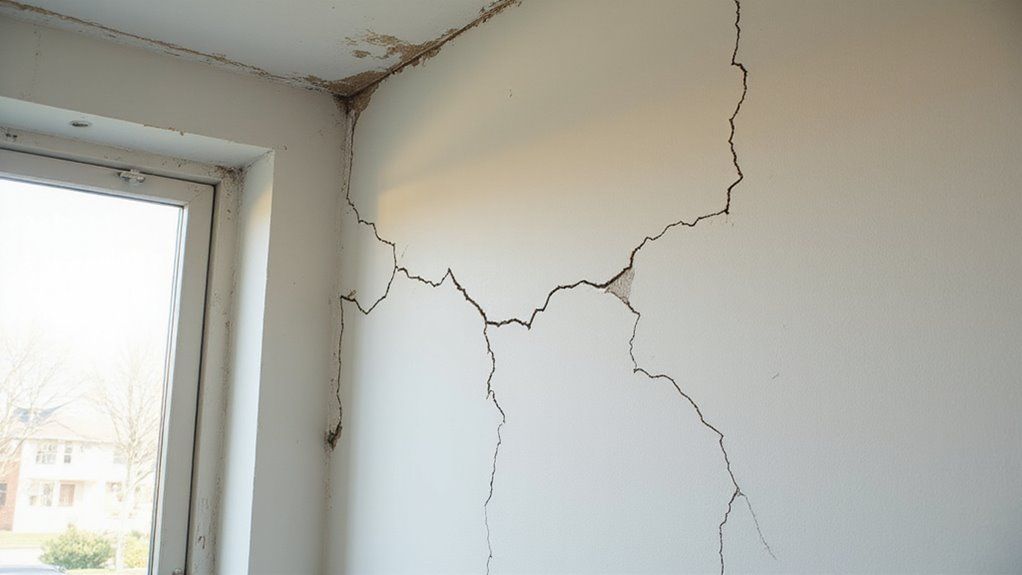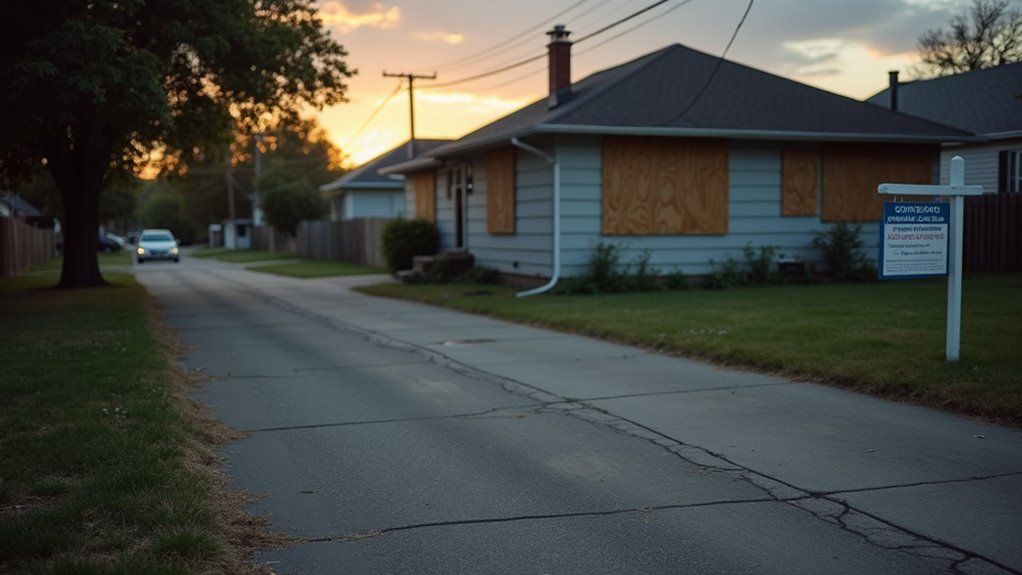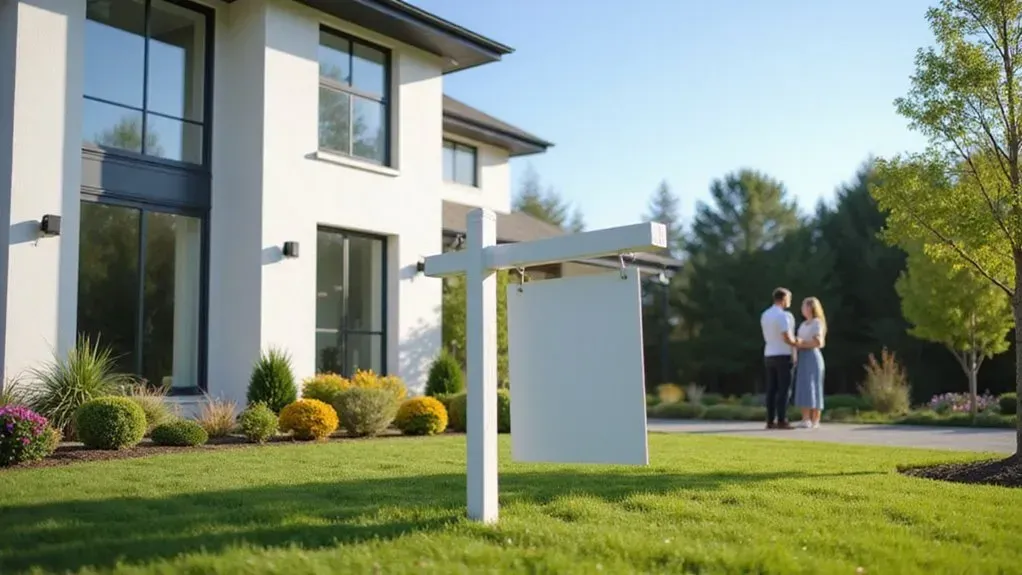
Selling your home can be stressful, especially when hidden foundation issues threaten your property’s value. Many homeowners overlook early warning signs that can lead to bigger problems down the road. If these issues go unchecked, you may face lower offers or failed inspections.
Small cracks or uneven floors can make buyers question your property’s condition. These problems often start small, but they can quickly escalate if ignored. The longer you wait, the harder it becomes to fix, and the more it can cost you at closing.
You can spot foundation issues before selling by learning to recognize early warning signs and taking action right away. Simple checks and regular monitoring give you confidence, boost your home’s value, and protect your negotiating power.
This blog will guide you step-by-step so you can sell your home without foundation worries.
Key Takeaways
- Inspect walls and ceilings for large, diagonal, or recurring cracks as these may signal foundation problems.
- Check for gaps around windows, doors, and visible separations between walls and ceilings indicating possible foundation shifts.
- Use a level or laser to detect uneven or sloping floors, especially near load-bearing walls and high-traffic areas.
- Examine exterior foundation walls, chimneys, and porches for cracks, tilting, or misalignment that suggest structural movement.
- Monitor sticking doors and windows, as frequent jamming or difficulty opening can indicate foundation settlement issues.
Recognizing Cracks in Walls and Ceilings
You can tell if a wall crack is serious by looking at its size and direction. Small, thin cracks are usually not a concern. If you see large or diagonal cracks, this could mean foundation problems.
Cracks wider than 1/8 inch or those forming a stair-step pattern are warning signs. Cracks spreading from windows or doors can also signal trouble. If repaired cracks keep coming back, the structure may be at risk.
Buyers often see wall and ceiling cracks as problems. Early detection and honest reporting can help avoid price cuts or delays in selling. If you notice suspicious cracks, a foundation expert should check your home soon. Recognizing Cracks in Walls and Ceilings is essential for assessing potential foundation issues before selling.
Understanding foundation movement can help homeowners determine the severity of cracks and decide when to seek professional evaluation.
Checking for Uneven or Sloping Floors
Uneven or sloping floors often mean there are foundation problems. You should check floors with a level or laser tool. Focus on areas near load-bearing walls and places with a lot of foot traffic.
Conducting meticulous research on signs of structural issues can help you identify potential problems early. If you see slopes or dips, the structure may be weak. Homes with these issues usually get lower offers from buyers. Many buyers worry about the cost of repairs. If you find uneven floors, you should call a structural engineer.
The engineer can suggest solutions like foundation reinforcement or pier systems. Addressing foundation concerns promptly can help prevent further damage and increase your home's value. Fixing floor problems early can protect your home's value and make selling easier.
Inspecting Doors and Windows for Alignment Issues
Foundation problems often cause doors and windows to become misaligned. Doors may not open or close smoothly if the foundation shifts. Windows can also become hard to slide or lock.
Check door frames for gaps at the top or bottom. Sticking, rubbing, or doors that do not latch may show structural movement. Look for these signs while inspecting each door.
Gaps in door frames or doors that stick and won’t latch can signal foundation movement—watch for these signs during your inspection.
Inspect windows for warping, cracked glass, or gaps between the sash and frame. These issues could mean there is foundation movement. If you find these problems, take action early, especially since foundation shifts can worsen over time if left unaddressed.
Potential buyers notice misaligned doors and windows. These issues can lower your home’s value. Address alignment problems before putting your home on the market.
Additionally, assessing the overall condition of the home can help identify hidden issues related to foundation shifts that might not be immediately visible.
Examining Exterior Foundation Walls
When you assess exterior foundation walls, focus on identifying horizontal, vertical, or stair-step cracks that may signal structural movement. Evaluate wall alignment by checking for bowing, bulging, or leaning, as these conditions often indicate compromised load-bearing capacity.
Industry data shows that early detection of these warning signs can significantly reduce long-term remediation costs. Recognizing warning signs early can help prevent costly repairs and protect the structural integrity of your property. Additionally, understanding foundational stability can guide you in making informed decisions before listing your home for sale.
Spotting Wall Cracks
Spotting wall cracks is important because they can show early signs of structural problems. If you check exterior foundation walls, you may catch issues before they get worse. Early detection helps protect your home's value.
Vertical cracks can mean the ground under the foundation is shifting. Horizontal cracks wider than a quarter-inch may show pressure from soil or water. Both types should be taken seriously.
Stair-step or diagonal cracks in brick or block walls can signal uneven movement in the foundation. If you see these cracks, you should get a professional opinion. Fixing problems early can make selling your home easier.
Checking Wall Alignment
To quickly check your foundation’s health, look at the exterior walls for straightness. Use a level tool to see if the walls are upright. If the walls lean or bow, this could mean foundation problems.
Peeling paint at the base of exterior walls can show moisture from foundation movement. Roof sagging might also point to foundation issues. Uneven walls can affect how weight is spread across your house.
Buyers notice these warning signs and may worry about repair costs. If you find problems early, you can fix them before selling. This helps protect your home’s value and gives buyers more confidence.
Spotting Gaps Around Window and Door Frames
Gaps around window and door frames are often signs of foundation problems. These gaps can appear if your home’s foundation shifts, settles, or moves. You should check for these gaps during regular home inspections. Navigating distressed sales can be complex, especially when foundation issues are involved, so early detection can save you time and money.
To ensure you’re working with a reputable professional, verify the cash buyer’s credentials and reputation before proceeding with any transactions. If you notice uneven spaces, daylight coming through, or hard-to-open windows and doors, your foundation may need attention. Such issues can hurt your home’s value and make selling harder. Buyers and inspectors may see these defects as warning signs.
If you fix window and door gaps early, you can protect your home’s structure. Early repairs can also help keep your property appealing to buyers. This will protect your investment and make selling easier if you decide to list your home.
Looking for Separation Between Walls and the Ceiling
You’ll want to watch for visible cracks or gaps where the walls meet the ceiling, as these are frequent indicators of foundation movement. Such separations often result from differential settlement, structural shifting, or moisture-related issues. If you notice these warning signs, it’s crucial to consult a foundation specialist promptly to prevent further structural compromise and protect your property’s value.
Additionally, understanding the market conditions can help determine whether now is a good time to sell or if you should address foundation repairs first. Being aware of selling improvements and features that turn off buyers, such as visible damage or structural issues, can further guide your decision-making process.
Common Separation Warning Signs
Visible gaps between walls and the ceiling are common warning signs of foundation problems. These gaps usually mean the house has shifted or settled. If you see these, the structure may not be stable.
You should look for cracks that run diagonally from ceiling corners. If any gap gets bigger over time, it is a serious concern. These issues often point to problems with the soil or foundation.
Buyers may notice these signs and question the home’s safety. This can lower your home’s value and make it harder to sell. If you document and monitor all gaps, you will be better prepared.
If addressed early, these problems are easier to fix. Fixing them can protect your investment and help you sell the house faster. Early repairs also reduce the chances of tough negotiations with buyers.
Causes Behind Wall Gaps
Wall gaps between the ceiling and walls usually mean there are problems with your home’s structure. These gaps often happen if the foundation settles or shifts. Water leaks and moving soil can also cause this issue.
If the framing moves, you might notice cracks in the paint or drywall. Sometimes, this movement can even harm electrical wires inside walls. Gaps may get worse during wet or dry seasons because soil expands and shrinks.
Visible wall gaps can make buyers worry about the home’s condition. If left unfixed, these problems may lower your property’s value. Fixing the underlying causes is important for a smooth sale.
When to Seek Help
Seek help if you see gaps growing between the ceiling and the walls. These changes can mean foundation problems, not just normal settling. A foundation expert should check the home if cracks get wider or new ones appear often.
Early repairs can save money when selling your home. Addressing issues before listing increases your home’s value and avoids last-minute surprises. Ignoring warning signs may lead to bigger repairs later.
If you notice doors or windows sticking, consider subsurface repairs or leveling. Widening gaps often require a structural engineer’s assessment. Repeated cracks may need foundation stabilization.
Add home repairs and landscaping to your pre-sale checklist. Overgrown tree roots or bad yard grading can make foundation issues worse. Taking action shows buyers you care for your property.
Assessing Chimney and Fireplace Stability
Chimneys and fireplaces can show early signs of foundation problems. These structures are separate from the main foundation. If they shift or crack, the foundation may be be moving indicating structural issues.
Check the outside bricks and inside firebox for cracks or gaps. Look for signs like step cracks or crumbling mortar. If you see these, there may be issues with the foundation or soil.
A fireplace that sags or a chimney that leans is a warning sign. These problems may lower property value and cause safety risks. If buyers notice these defects, it can affect the sale.
If you find any of these signs, fix them before selling. Addressing issues early can help you avoid costly repairs later. Proper inspection can help identify underlying structural concerns before listing your home.
Observing Basement and Crawl Space Conditions
Basements and crawl spaces often show the first signs of foundation problems. Inspect these areas for moisture, damage, and weak structures. Early detection makes repairs easier and less expensive. Checking for proper drainage around the foundation can also prevent water intrusion and related issues. Proper drainage is essential to maintain foundation integrity and avoid costly repairs.
Check basement insulation for any wear or damage. Damaged insulation may mean hidden moisture or stress on the structure. If insulation is in poor condition, further investigation is needed.
Inspect crawl space vents to be sure they are clear and working well. Inadequate ventilation can cause wood rot and hide other problems. Proper airflow helps prevent these issues.
Look for uneven floors, cracks in the walls, or moved supports. These signs often mean the foundation is shifting. If you find these issues, consult a professional.
Well-kept basements and crawl spaces add value and boost buyer trust. Address problems before listing your home for sale. Early action can prevent costly repairs after an inspection.
Identifying Moisture or Water Intrusion Signs
You’ll want to recognize basement dampness indicators, as persistent moisture can signal foundation vulnerabilities that impact property value. Pay attention to wall staining clues and any musty odor presence, both of which often denote ongoing water intrusion issues. Early identification of these signs enables proactive remediation and helps protect your investment.
Basement Dampness Indicators
Homeowners can spot early basement moisture by looking for a musty smell or damp air. Condensation on pipes and wet spots on walls are warning signs. If these signs appear, moisture may be entering your basement.
Insulation that looks warped or feels wet often means there is a moisture problem. Efflorescence, which is white powder on concrete, also signals water issues. If the floor feels soft or shows stains, this can mean hidden dampness.
A hygrometer can help you measure basement humidity. If humidity stays over 60%, there is likely not enough moisture control. Fixing these problems early can prevent bigger and more expensive repairs.
In today’s real estate market, buyers notice basement issues. If you address dampness soon, your home can become more valuable. Early action can also make selling your home easier.
Wall Staining Clues
Wall staining is a clear sign of water or moisture problems in a basement. Stains on the walls often mean water is coming through the foundation. Yellow, brown, or gray marks are common signs.
Paint peeling along the bottom of walls may show long-term dampness. Efflorescence, which is a white powder, means water is moving through the masonry. These signs can point to possible foundation issues.
If you see these clues, you should fix them before selling your home. Doing so shows buyers that you take care of your property. This could help you get a better price and smoother negotiations.
Musty Odor Presence
A musty odor in your basement or crawl space usually means there is too much moisture. This smell often comes from mold or water problems. If you notice it, your home may have hidden foundation issues.
Mold grows when humidity is high, which can harm air quality. Buyers often see musty smells as a warning sign. If you are selling, this odor can lower your home’s value.
You should check for mold, wet insulation, or water on pipes and walls. If you find any, fix the moisture source and clean up the mold. Taking these steps can help keep your home’s structure safe and appeal to buyers.
Monitoring for Bowing or Bulging Walls
Bowing or bulging walls can mean there are serious problems with your home’s structure. Homeowners should watch these walls for any changes over time. If you see cracks, inward bending, or shifting, it could be a sign of foundation trouble.
You should check the walls each month with a level or laser tool. Record any changes you notice and compare them to past notes. If the wall moves more over time, it may be getting worse.
Visible wall problems can lower your home’s value and scare off buyers. If you notice the problem getting worse, contact a structural engineer. Early repairs help keep your home safe and protect its value.
Testing for Sticky or Jammed Doors
Sticky or jammed doors are often a sign of foundation problems. Check all doors in your home for sticking, jamming, or trouble closing. These issues can mean the foundation has shifted.
A door that drags on the floor or is hard to latch may be out of alignment. Lubricating the hinges can fix squeaks, but not structural problems. If the issue continues, the cause might be the foundation.
Unresolved door problems can lower your home’s value. Buyers may avoid homes with these issues. If you note recurring problems, you can plan repairs and give honest information to buyers.
Evaluating Garage and Porch Stability
When assessing garage and porch stability, you should watch for uneven concrete surfaces that may indicate differential settlement or slab heaving. It's essential to inspect support post alignment, as misalignment often signals underlying structural movement. Addressing these issues promptly protects property value and mitigates costly repairs.
Detecting Uneven Concrete Surfaces
Uneven concrete surfaces are often a sign of problems underneath. Cracks, sloping, or sunken areas can mean the soil has shifted. These changes may signal foundation issues that need attention.
Foundation movement often happens because of poor drainage or weak soil. Expanding clay or erosion may cause the ground to settle unevenly. If you see these signs, consider checking the area more closely.
A long level or straightedge helps you spot uneven spots easily. Even small height changes can affect your home’s value. Buyers may worry about expensive repairs if they notice these problems.
If you find uneven concrete, act early to fix it. Early repairs can protect your property and keep buyers interested. Proactive steps show you care for your home and its condition.
Inspecting Support Post Alignment
Support post alignment means checking if your posts are straight and secure. Leaning or shifting posts suggest there could be bigger problems. Misaligned posts can lead to structural issues in your garage or porch.
Use a level or a laser tool to check if posts are vertical. If you see any tilt, there may be soil movement or settling. Always inspect the base and top for cracks, gaps, or other damage.
Unfixed post issues can lower your home’s value in today’s market. Buyers may worry about safety if posts are not aligned. If you fix these problems before selling, you can avoid last-minute price cuts.
Reviewing Landscaping and Drainage Patterns
Proper landscaping and drainage help keep your foundation stable over time. Water should always flow away from your home. If it does not, you could face moisture problems and foundation damage.
Check how water moves after rain and see if it collects near your house. Pooling water or erosion in your yard shows poor drainage. Garden sprinklers or beds too close to the house can also cause trouble.
Buyers notice signs of water issues and may worry about future repairs. If you fix these problems before selling, your home is more attractive. Proper drainage and landscaping can protect your property’s value and help you sell faster.
Knowing When to Call a Professional Inspector
You should call a professional inspector if you see signs of foundation problems. These signs include uneven floors, cracks in walls, or gaps around windows and doors. An expert can find issues you might miss.
Inspectors check the strength of the foundation materials like concrete or brick. They look for hidden problems that could cause future damage. Early detection can save you money.
Inspectors assess foundation strength and spot hidden issues early, helping prevent future damage and expensive repairs.
If you plan to sell, a clean inspection report helps attract buyers. Undetected foundation issues can lower your property’s value. Professional advice ensures repairs are done right.
A qualified inspector gives you clear recommendations based on your home’s needs. This helps you fix problems quickly and correctly. Taking action early builds buyer confidence and protects your investment.
Conclusion
If you want to sell your home quickly, you should address any foundation issues before listing. If you ignore these problems, you might face lower offers or delayed sales. A professional inspection can help you identify and resolve concerns early.
If you need a simple and fast sale, we buy houses for cash. Jay Primrose Properties can provide an offer even if your home needs repairs. We handle the process so you do not have to worry about costly fixes.
If you are ready to sell, contact us today. We will guide you every step of the way. Let Jay Primrose Properties make your home sale smooth and stress-free.
Give us a call anytime at 253-697-0007 or fill out this quick form to get started today!
Get A Fair Cash Offer On Your House

About the author
Justin Baker
Justin Baker is the founder of Jay Primrose Properties, a leading cash home buying company based in Tacoma, WA. With a passion for real estate investing, Justin has helped numerous homeowners in the Pacific Northwest region sell their homes quickly and hassle-free. Justin believes that buying and selling real estate should be a seamless process and works tirelessly to ensure that his clients have a stress-free experience. With a deep understanding of the local real estate market and a commitment to exceptional customer service, Justin has established himself as a trusted and reliable cash home buyer in Tacoma and the surrounding areas.











